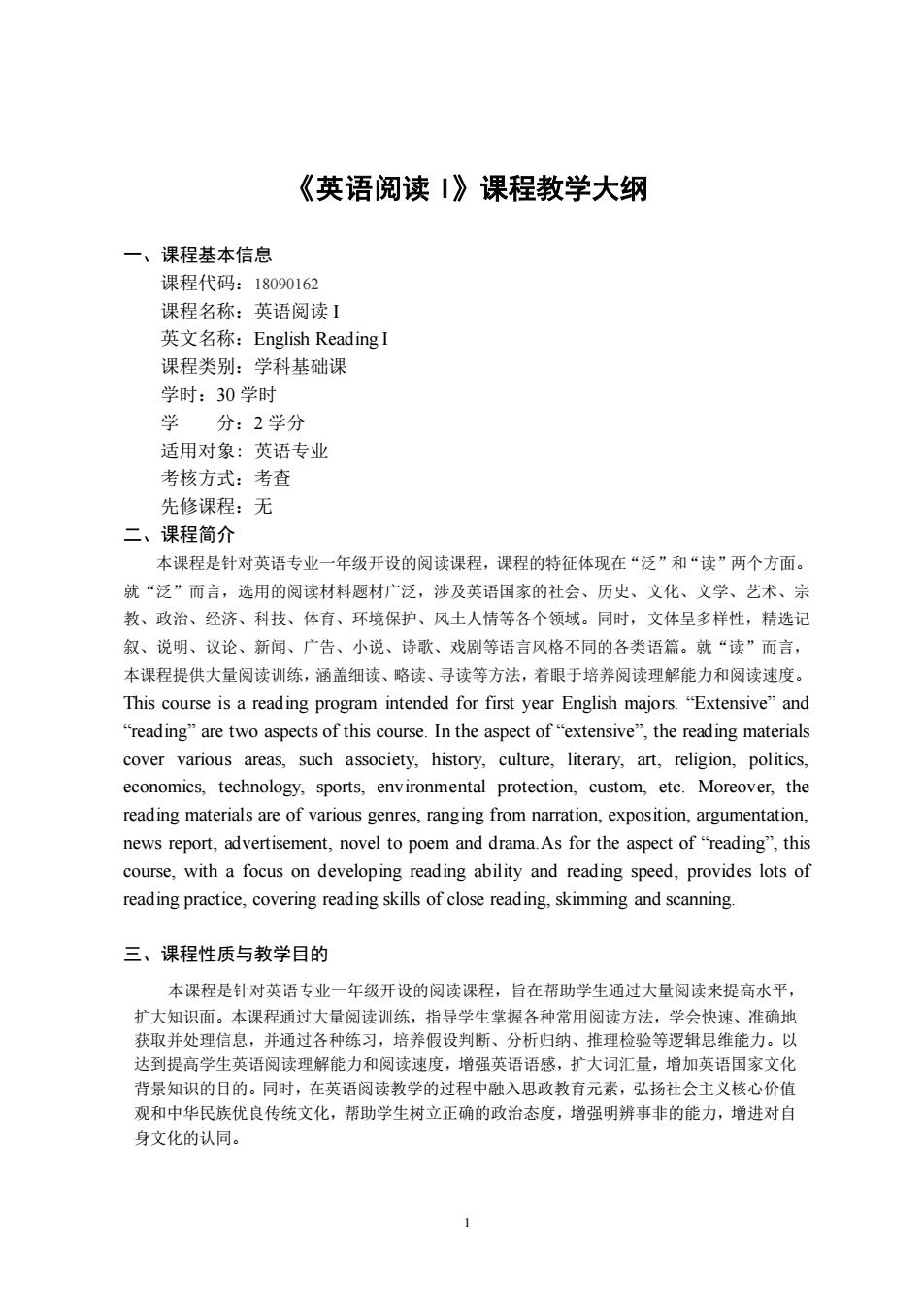
《英语阅读1》课程教学大纲 一、课程基本信息 课程代码:18090162 课程名称:英语阅读I 英文名称:English Reading 课程类别:学科基础课 学时:30学时 学分:2学分 适用对象:英语专业 考核方式:考查 先修课程:无 二、课程简介 本课程是针对英语专业一年级开设的阅读课程,课程的特征体现在“泛”和“读”两个方面。 就“泛”而言,选用的阅读材料题材广泛,涉及英语国家的社会、历史、文化、文学、艺术、宗 教、政治、经济、科技、体有、环境保护、风土人情等各个领域。同时,文体呈多样性,精选记 叙、说明、议论、新闻、广告、小说、诗歌、戏剧等语言风格不同的各类语篇。就“读”而言, 本课程提供大量阅读训练,涵盖细读、略读、寻读等方法,着眼于培养阅读理解能力和阅读速度。 This course is a reading program intended for first year English majors."Extensive"and “reading”are two aspects of this course.In the aspect of“extensive”,the reading materials cover various areas,such associety,history,culture,literary,art,religion,politics economics,technology,sports,environmental protection,custom,etc.Moreover,the reading materials are of various genres,ranging from narration,exposition,argumentation news report,advertisement,novel to poem and drama.As for the aspect of"reading",this course,with a focus on developing reading ability and reading speed,provides lots of reading practice,covering reading skills of close reading,skimming and scanning. 三、课程性质与教学目的 本课程是针对英语专业一年级开设的阅读课程,旨在帮助学生通讨大量阅读来提高水平 扩大知识面。本课程通过大量阅读训练,指导学生掌握各种常用阅读方法,学会快 、准确地 获取并处理信息,并通过各种练习,培养假设判断、分析归钠、推理检验等逻辑思维能力。以 达到提高学生英语阅读理解能力和阅读速度,增强英语语感,扩大词汇量,增加英语国家文化 背景知识的目的。同时,在英语阅读教学的过程中融入思政教育元素,弘扬社会主义核心价值 观和中华民族优良传统文化,帮助学生树立正确的政治态度,增强明辨事非的能力,增进对自 身文化的认同
1 《英语阅读 I》课程教学大纲 一、课程基本信息 课程代码:18090162 课程名称:英语阅读 I 英文名称:English Reading I 课程类别:学科基础课 学时:30 学时 学 分:2 学分 适用对象: 英语专业 考核方式:考查 先修课程:无 二、课程简介 本课程是针对英语专业一年级开设的阅读课程,课程的特征体现在“泛”和“读”两个方面。 就“泛”而言,选用的阅读材料题材广泛,涉及英语国家的社会、历史、文化、文学、艺术、宗 教、政治、经济、科技、体育、环境保护、风土人情等各个领域。同时,文体呈多样性,精选记 叙、说明、议论、新闻、广告、小说、诗歌、戏剧等语言风格不同的各类语篇。就“读”而言, 本课程提供大量阅读训练,涵盖细读、略读、寻读等方法,着眼于培养阅读理解能力和阅读速度。 This course is a reading program intended for first year English majors. “Extensive” and “reading” are two aspects of this course. In the aspect of “extensive”, the reading materials cover various areas, such associety, history, culture, literary, art, religion, politics, economics, technology, sports, environmental protection, custom, etc. Moreover, the reading materials are of various genres, ranging from narration, exposition, argumentation, news report, advertisement, novel to poem and drama.As for the aspect of “reading”, this course, with a focus on developing reading ability and reading speed, provides lots of reading practice, covering reading skills of close reading, skimming and scanning. 三、课程性质与教学目的 本课程是针对英语专业一年级开设的阅读课程,旨在帮助学生通过大量阅读来提高水平, 扩大知识面。本课程通过大量阅读训练,指导学生掌握各种常用阅读方法,学会快速、准确地 获取并处理信息,并通过各种练习,培养假设判断、分析归纳、推理检验等逻辑思维能力。以 达到提高学生英语阅读理解能力和阅读速度,增强英语语感,扩大词汇量,增加英语国家文化 背景知识的目的。同时,在英语阅读教学的过程中融入思政教育元素,弘扬社会主义核心价值 观和中华民族优良传统文化,帮助学生树立正确的政治态度,增强明辨事非的能力,增进对自 身文化的认同
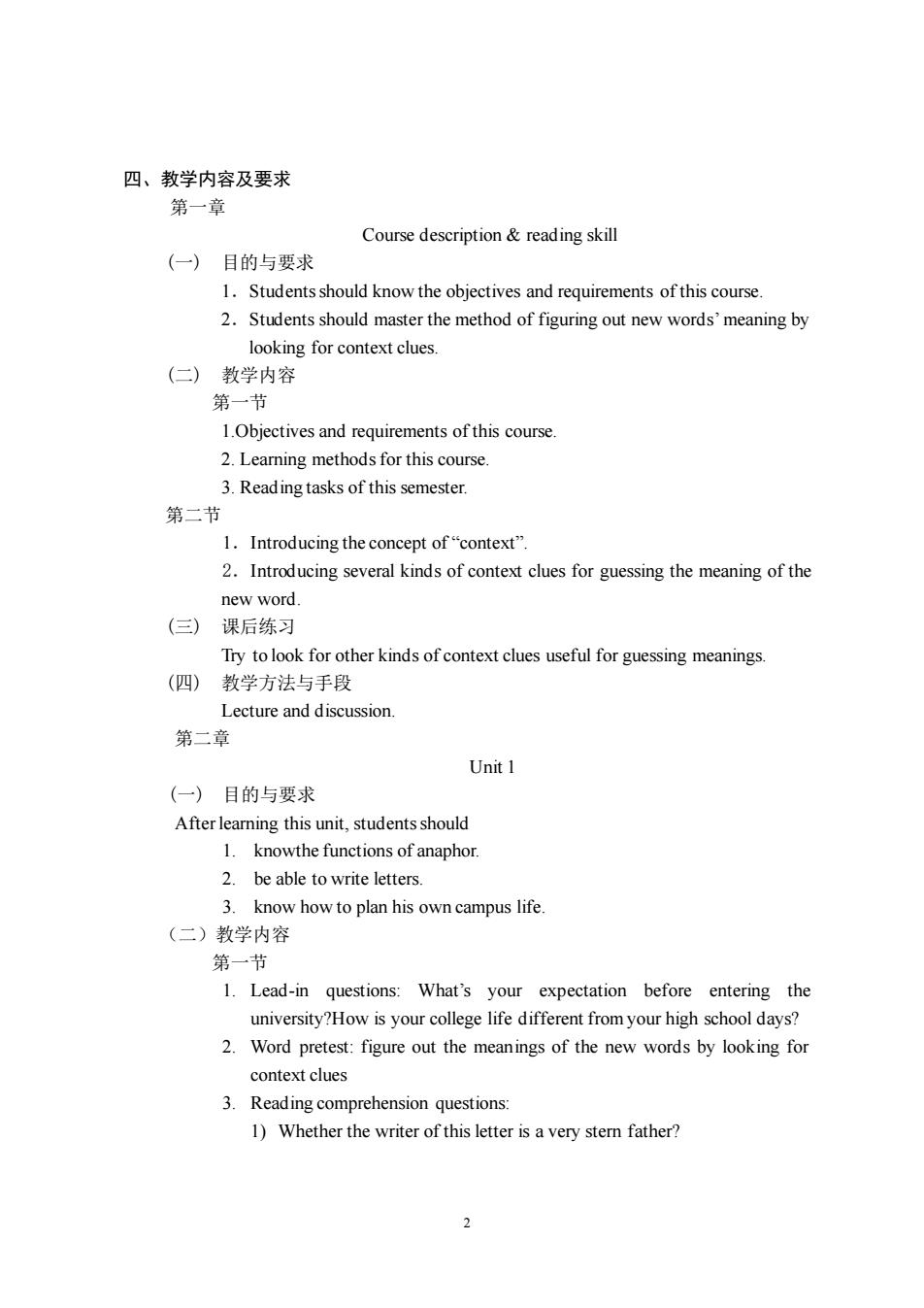
四、教学内容及要求 第一章 Course description&reading skill (一)目的与要求 1.Students should know the objectives and requirements of this course. 2.Students should master the method of figuring out new words'meaning by looking for context clues. (仁)教学内容 第一节 1.Objectives and requirements of this course. 2.Leamning methods for this course. 3.Reading tasks of this semester. 第二节 1.Introducing the concept of"context". 2.Introducing several kinds of context clues for guessing the meaning of the new word (三)课后练习 Try to look for other kinds of context clues useful for guessing meanings. (四)教学方法与手段 Lecture and discussion. 第二章 Unit1 (一)目的与要求 After learning this unit,students should 1.knowthe functions of anaphor 2.be able to write letters. 3.know how to plan his own campus life. (二)教学内容 第一节 1.Lead-in questions:What's your expectation before entering the university?How is your college life different from your high school days? 2.Word pretest:figure out the meanings of the new words by looking for context clues 3.Reading comprehension questions: 1)Whether the writer of this letter is a very stemn father? 2
2 四、教学内容及要求 第一章 Course description & reading skill (一) 目的与要求 1.Students should know the objectives and requirements of this course. 2.Students should master the method of figuring out new words’ meaning by looking for context clues. (二) 教学内容 第一节 1.Objectives and requirements of this course. 2. Learning methods for this course. 3. Reading tasks of this semester. 第二节 1.Introducing the concept of “context”. 2.Introducing several kinds of context clues for guessing the meaning of the new word. (三) 课后练习 Try to look for other kinds of context clues useful for guessing meanings. (四) 教学方法与手段 Lecture and discussion. 第二章 Unit 1 (一) 目的与要求 After learning this unit, students should 1. knowthe functions of anaphor. 2. be able to write letters. 3. know how to plan his own campus life. (二)教学内容 第一节 1. Lead-in questions: What’s your expectation before entering the university?How is your college life different from your high school days? 2. Word pretest: figure out the meanings of the new words by looking for context clues 3. Reading comprehension questions: 1) Whether the writer of this letter is a very stern father?
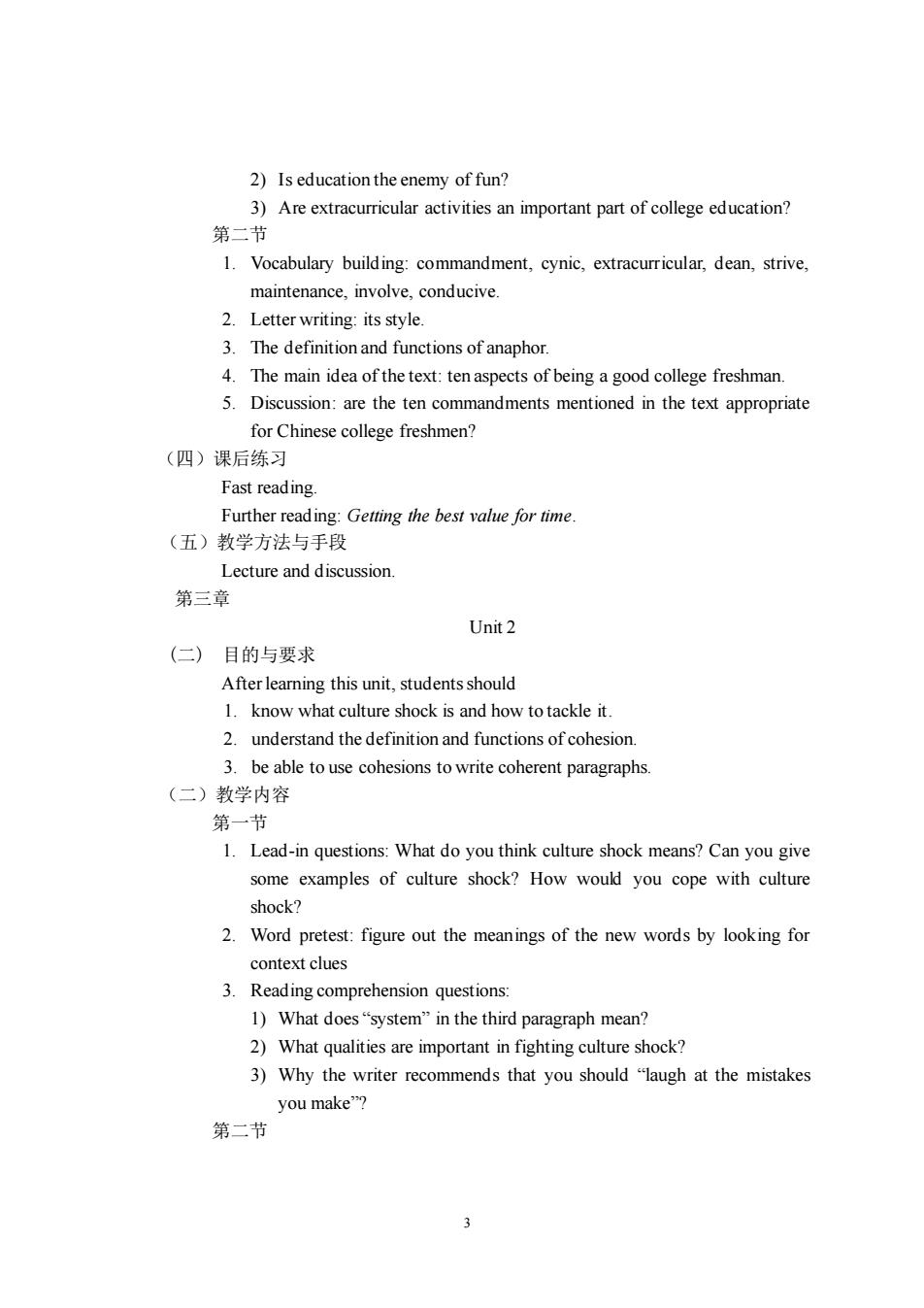
2)Is education the enemy of fun? 3)Are extracurricular activities an important part of college education? 第二节 1.Vocabulary building:commandment,cynic,extracurricular,dean,strive. maintenance,involve,conducive. 2.Letter writing:its style. 3.The definition and functions of anaphor 4.The main idea of the text:ten aspects of being a good college freshman. 5.Discussion:are the ten commandments mentioned in the text appropriate for Chinese college freshmen? (四)课后练习 Fast reading Further reading:Getting the best value for time (五)教学方法与手段 Lecture and discussion 第三章 Unit2 (二)目的与要求 After leaming this unit,students should 1.know what culture shock is and how to tackle it. 2.understand the definition and functions of cohesion 3.be able to use cohesions to write coherent paragraphs (二)教学内容 第一节 1.Lead-in questions:What do you think culture shock means?Can you give some examples of culture shock?How would you cope with culture shock? 2.Word pretest:figure out the meanings of the new words by looking for context clues 3.Reading comprehension questions: 1)What does"system"in the third paragraph mean? 2)What qualities are important in fighting culture shock? 3)Why the writer recommends that you should "laugh at the mistakes you make"? 第二节 3
3 2) Is education the enemy of fun? 3) Are extracurricular activities an important part of college education? 第二节 1. Vocabulary building: commandment, cynic, extracurricular, dean, strive, maintenance, involve, conducive. 2. Letter writing: its style. 3. The definition and functions of anaphor. 4. The main idea of the text: ten aspects of being a good college freshman. 5. Discussion: are the ten commandments mentioned in the text appropriate for Chinese college freshmen? (四)课后练习 Fast reading. Further reading: Getting the best value for time. (五)教学方法与手段 Lecture and discussion. 第三章 Unit 2 (二) 目的与要求 After learning this unit, students should 1. know what culture shock is and how to tackle it. 2. understand the definition and functions of cohesion. 3. be able to use cohesions to write coherent paragraphs. (二)教学内容 第一节 1. Lead-in questions: What do you think culture shock means? Can you give some examples of culture shock? How would you cope with culture shock? 2. Word pretest: figure out the meanings of the new words by looking for context clues 3. Reading comprehension questions: 1) What does “system” in the third paragraph mean? 2) What qualities are important in fighting culture shock? 3) Why the writer recommends that you should “laugh at the mistakes you make”? 第二节
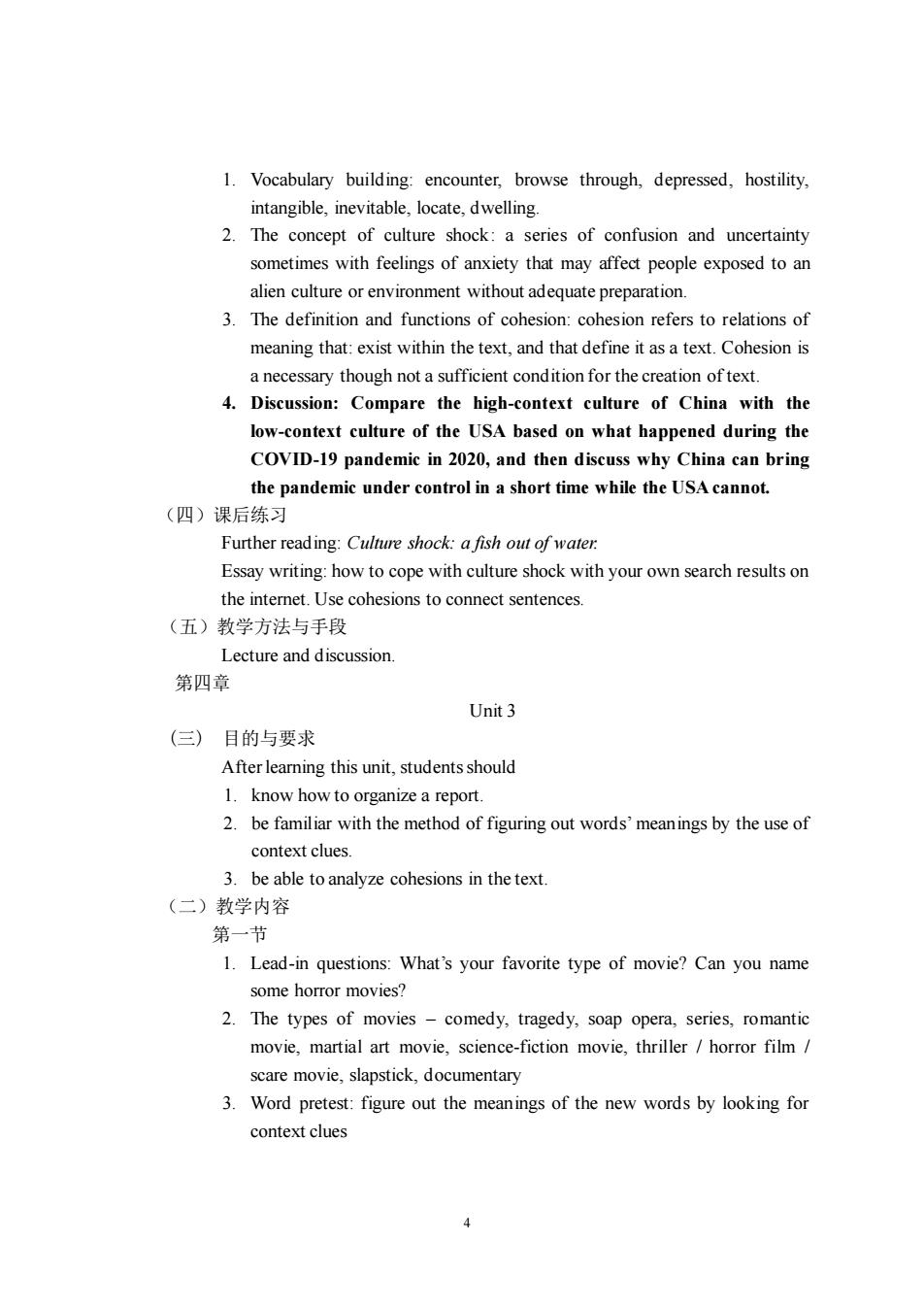
1.Vocabulary building:encounter,browse through,depressed,hostility intangible,inevitable,locate,dwelling. 2.The concept of culture shock:a series of confusion and uncertainty sometimes with feelings of anxiety that may affect people exposed to an alien culture or environment without adequate preparation. 3.The definition and functions of cohesion:cohesion refers to relations of meaning that:exist within the text,and that define it as a text.Cohesion is a necessary though not a sufficient condition for the creation of text. 4.Discussion:Compare the high-context culture of China with the low-context culture of the USA based on what happened during the COVID-19 pandemic in 2020,and then discuss why China can bring the pandemic under control in a short time while the USA cannot. (四)课后练习 Further read ing:Culture shock:a fish out of water Essay writing:how to cope with culture shock with your own search results on the internet.Use cohesions to connect sentences. (五)教学方法与手段 Lecture and discussion. 第四章 Unit 3 (三)目的与要求 After learning this unit,students should 1.know how to organize a report. 2.be familiar with the method of figuring out words'meanings by the use of context clues 3.be able to analyze cohesions in the text. (二)教学内容 第一节 1.Lead-in questions:What's your favorite type of movie?Can you name some horror movies? 2.The types of movies-comedy,tragedy,soap opera,series,romantic movie,martial art movie,science-fiction movie,thriller /horror film/ scare movie,slapstick,documentary 3.Word pretest:figure out the meanings of the new words by looking for context clues 4
4 1. Vocabulary building: encounter, browse through, depressed, hostility, intangible, inevitable, locate, dwelling. 2. The concept of culture shock: a series of confusion and uncertainty sometimes with feelings of anxiety that may affect people exposed to an alien culture or environment without adequate preparation. 3. The definition and functions of cohesion: cohesion refers to relations of meaning that: exist within the text, and that define it as a text. Cohesion is a necessary though not a sufficient condition for the creation of text. 4. Discussion: Compare the high-context culture of China with the low-context culture of the USA based on what happened during the COVID-19 pandemic in 2020, and then discuss why China can bring the pandemic under control in a short time while the USA cannot. (四)课后练习 Further reading: Culture shock: a fish out of water. Essay writing: how to cope with culture shock with your own search results on the internet. Use cohesions to connect sentences. (五)教学方法与手段 Lecture and discussion. 第四章 Unit 3 (三) 目的与要求 After learning this unit, students should 1. know how to organize a report. 2. be familiar with the method of figuring out words’ meanings by the use of context clues. 3. be able to analyze cohesions in the text. (二)教学内容 第一节 1. Lead-in questions: What’s your favorite type of movie? Can you name some horror movies? 2. The types of movies – comedy, tragedy, soap opera, series, romantic movie, martial art movie, science-fiction movie, thriller / horror film / scare movie, slapstick, documentary 3. Word pretest: figure out the meanings of the new words by looking for context clues
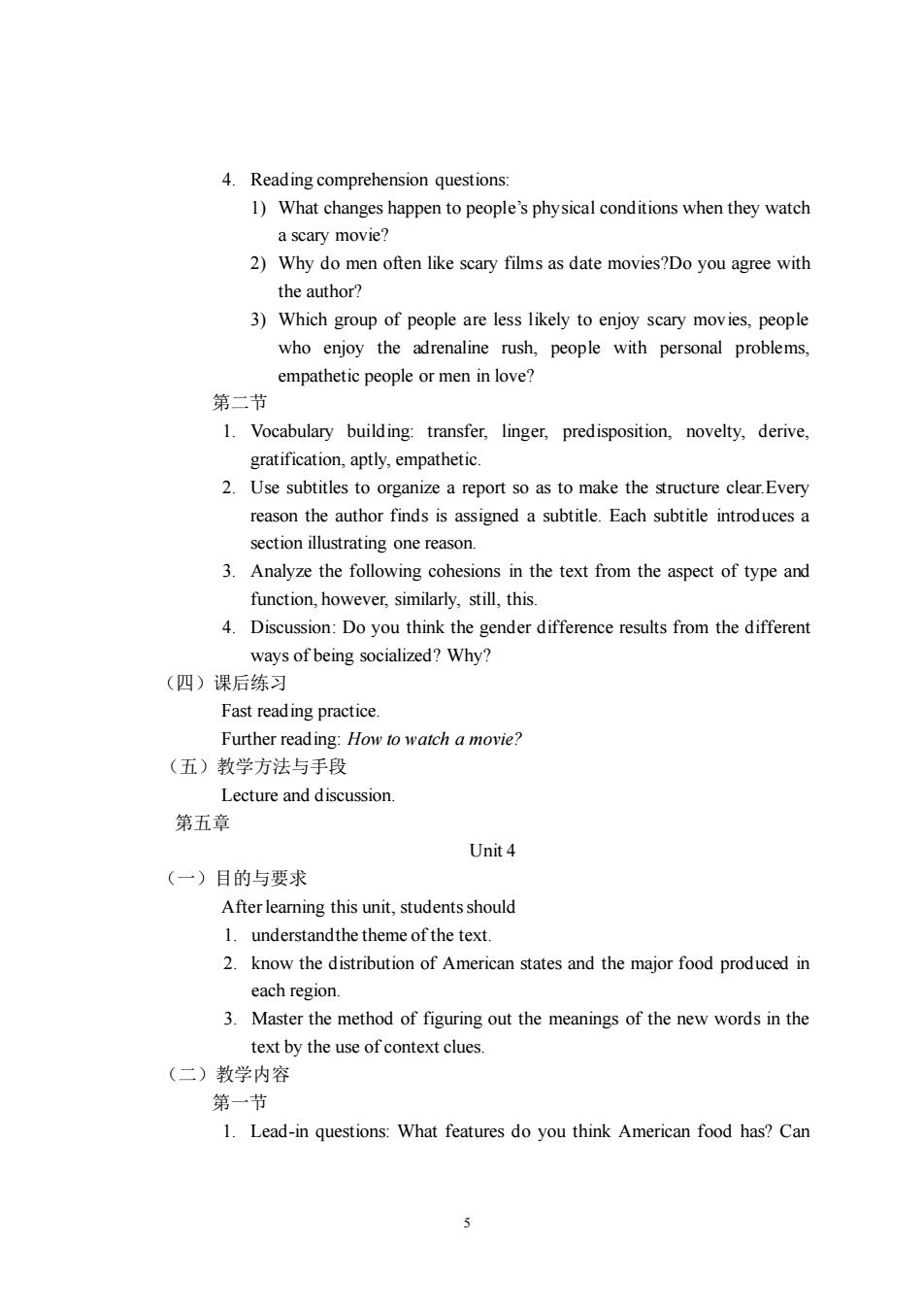
4.Reading comprehension questions: 1)What changes happen to people's physical conditions when they watch a scary movie? 2)Why do men often like scary films as date movies?Do you agree with the author? 3)Which group of people are less likely to enjoy scary movies,people who enjoy the adrenaline rush,people with personal problems empathetic people or men in love? 第二节 1.Vocabulary building:transfer,linger,predisposition,novelty,derive, gratification,aptly,empathetic. 2.Use subtitles to organize a report so as to make the structure clear.Every reason the author finds is assigned a subtitle.Each subtitle introduces a section illustrating one reason. 3.Analyze the following cohesions in the text from the aspect of type and function,however,similarly,still,this. 4. Discussion:Do you think the gender difference results from the different ways of being socialized?Why? (四)课后练习 Fast reading practice. Further reading:How to watch a movie? (五)教学方法与手段 Lecture and discussion 第五章 Unit4 (一)目的与要求 After learning this unit,students should 1.understandthe theme of the text. 2.know the distribution of American states and the major food produced in each region. 3.Master the method of figuring out the meanings of the new words in the text by the use of context clues (二)教学内容 第一节 1.Lead-in questions:What features do you think American food has?Can
5 4. Reading comprehension questions: 1) What changes happen to people’s physical conditions when they watch a scary movie? 2) Why do men often like scary films as date movies?Do you agree with the author? 3) Which group of people are less likely to enjoy scary movies, people who enjoy the adrenaline rush, people with personal problems, empathetic people or men in love? 第二节 1. Vocabulary building: transfer, linger, predisposition, novelty, derive, gratification, aptly, empathetic. 2. Use subtitles to organize a report so as to make the structure clear.Every reason the author finds is assigned a subtitle. Each subtitle introduces a section illustrating one reason. 3. Analyze the following cohesions in the text from the aspect of type and function, however, similarly, still, this. 4. Discussion: Do you think the gender difference results from the different ways of being socialized? Why? (四)课后练习 Fast reading practice. Further reading: How to watch a movie? (五)教学方法与手段 Lecture and discussion. 第五章 Unit 4 (一)目的与要求 After learning this unit, students should 1. understandthe theme of the text. 2. know the distribution of American states and the major food produced in each region. 3. Master the method of figuring out the meanings of the new words in the text by the use of context clues. (二)教学内容 第一节 1. Lead-in questions: What features do you think American food has? Can